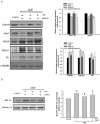Oligo-Fucoidan Improves Diabetes-Induced Renal Fibrosis via Activation of Sirt-1, GLP-1R, and Nrf2/HO-1: An In Vitro and In Vivo Study
- PMID: 33049944
- PMCID: PMC7650749
- DOI: 10.3390/nu12103068
Oligo-Fucoidan Improves Diabetes-Induced Renal Fibrosis via Activation of Sirt-1, GLP-1R, and Nrf2/HO-1: An In Vitro and In Vivo Study
Abstract
Fucoidan extracted from brown algae has multiple beneficial functions. In this study, we investigated the effects of low-molecular-weight fucoidan (oligo-FO) on renal fibrosis under in vitro and in vivo diabetic conditions, and its molecular mechanisms. Advanced glycation product (AGE)-stimulated rat renal proximal tubular epithelial cells (NRK-52E) and diabetic mice induced by high-fat diet and intraperitoneal injection of streptozotocin and nicotinamide were used. Oligo-FO treatment significantly inhibited anti-high mobility group box 1 (HMGB1)/RAGE/ anti-nuclear factor-kappa B (NF-κB)/transforming growth factor-β1 (TGF-β1)/TGF-β1R/Smad 2/3/fibronectin signaling pathway and HIF-1α activation in AGE-stimulated NRK-52E cells. Conversely, the expression and activity of Sirt-1; the levels of ubiquitin-specific peptidase 22 (USP22), p-AMPK, glucagon-like peptide-1 receptor (GLP-1R), and heme oxygenase-1 (HO-1); and Nrf2 activation were remarkably increased by oligo-FO in AGE-stimulated cells. However, the above effects of oligo-FO were greatly diminished by inhibiting Sirt-1, HO-1, or GLP-1R activity. Similar changes of these pro-fibrotic genes in the kidney and a marked attenuation of renal injury and dysfunction were observed in oligo-FO-treated diabetic mice. These findings indicated that the inhibitory effects of the oligo-FO on diabetes-evoked renal fibrosis are mediated by suppressing TGF-β1-activated pro-fibrogenic processes via Sirt-1, HO-1, and GLP-1R dependence. Collectively, fucoidan-containing foods or supplements may be potential agents for ameliorating renal diseases due to excessive fibrosis.
Keywords: Sirt-1; diabetes; fucoidan; glucagon-like peptide-1 receptor; renal fibrosis; transforming growth factor-β.
Conflict of interest statement
The authors declare no conflict of interest.
Figures






Similar articles
-
Fucoidan ameliorates pancreatic β-cell death and impaired insulin synthesis in streptozotocin-treated β cells and mice via a Sirt-1-dependent manner.Mol Nutr Food Res. 2017 Oct;61(10). doi: 10.1002/mnfr.201700136. Epub 2017 Jun 8. Mol Nutr Food Res. 2017. PMID: 28493611
-
Sirt1 resists advanced glycation end products-induced expressions of fibronectin and TGF-β1 by activating the Nrf2/ARE pathway in glomerular mesangial cells.Free Radic Biol Med. 2013 Dec;65:528-540. doi: 10.1016/j.freeradbiomed.2013.07.029. Epub 2013 Jul 24. Free Radic Biol Med. 2013. PMID: 23891678
-
Polydatin promotes Nrf2-ARE anti-oxidative pathway through activating Sirt1 to resist AGEs-induced upregulation of fibronetin and transforming growth factor-β1 in rat glomerular messangial cells.Mol Cell Endocrinol. 2015 Jan 5;399:178-89. doi: 10.1016/j.mce.2014.08.014. Epub 2014 Sep 2. Mol Cell Endocrinol. 2015. PMID: 25192797
-
Protective effects of fucoidan against kidney diseases: Pharmacological insights and future perspectives.Int J Biol Macromol. 2022 Jun 1;209(Pt B):2119-2129. doi: 10.1016/j.ijbiomac.2022.04.192. Epub 2022 Apr 29. Int J Biol Macromol. 2022. PMID: 35500767 Review.
-
[Roles of ferroptosis in the development of diabetic nephropathy].Zhejiang Da Xue Xue Bao Yi Xue Ban. 2024 Dec 25;53(6):708-714. doi: 10.3724/zdxbyxb-2024-0114. Zhejiang Da Xue Xue Bao Yi Xue Ban. 2024. PMID: 39757741 Free PMC article. Review. Chinese.
Cited by
-
Fucoidan-Mediated Inhibition of Fibrotic Properties in Oral Submucous Fibrosis via the MEG3/miR-181a/Egr1 Axis.Pharmaceuticals (Basel). 2022 Jul 5;15(7):833. doi: 10.3390/ph15070833. Pharmaceuticals (Basel). 2022. PMID: 35890132 Free PMC article.
-
Icariin Ameliorates Diabetic Renal Tubulointerstitial Fibrosis by Restoring Autophagy via Regulation of the miR-192-5p/GLP-1R Pathway.Front Pharmacol. 2021 Jul 19;12:720387. doi: 10.3389/fphar.2021.720387. eCollection 2021. Front Pharmacol. 2021. PMID: 34349660 Free PMC article.
-
Fucoidan inhibits apoptosis and improves cardiac remodeling by inhibiting p53 transcriptional activation through USP22/Sirt 1.Front Pharmacol. 2023 May 30;14:1164333. doi: 10.3389/fphar.2023.1164333. eCollection 2023. Front Pharmacol. 2023. PMID: 37324479 Free PMC article.
-
Therapeutic Effect of Natural Products and Dietary Supplements on Aflatoxin-Induced Nephropathy.Int J Mol Sci. 2024 Mar 1;25(5):2849. doi: 10.3390/ijms25052849. Int J Mol Sci. 2024. PMID: 38474096 Free PMC article.
-
Effects of oligo-fucoidan on the immune response, inflammatory status and pulmonary function in patients with asthma: a randomized, double-blind, placebo-controlled trial.Sci Rep. 2022 Oct 28;12(1):18150. doi: 10.1038/s41598-022-21527-3. Sci Rep. 2022. PMID: 36307493 Free PMC article. Clinical Trial.
References
-
- Svensson M., Sundkvist G., Arnqvist H.J., Björk E., Blohmé G., Bolinder J., Henricsson M., Nyström L., Torffvit O., Waernbaum I., et al. Signs of nephropathy may occur early in young adults with diabetes despite modern diabetes management: Results from the nationwide population-based Diabetes Incidence Study in Sweden (DISS) Diabetes Care. 2003;26:2903–2909. doi: 10.2337/diacare.26.10.2903. - DOI - PubMed
MeSH terms
Substances
Grants and funding
LinkOut - more resources
Full Text Sources
Medical

